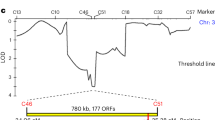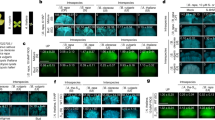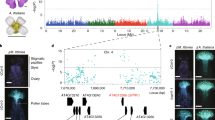Abstract
In plants, cell–cell recognition is a crucial step in the selection of optimal pairs of gametes to achieve successful propagation of progeny. Flowering plants have evolved various genetic mechanisms, mediated by cell–cell recognition, to enable their pistils to reject self-pollen, thus preventing inbreeding and the consequent reduced fitness of progeny (self-incompatibility, SI), and to reject foreign pollen from other species, thus maintaining species identity (interspecific incompatibility)1. In the genus Brassica, the SI system is regulated by an S-haplotype-specific interaction between a stigma-expressed female receptor (S receptor kinase, SRK) and a tapetum cell-expressed male ligand (S locus protein 11, SP11), encoded by their respective polymorphic genes at the S locus2–6. However, the molecular mechanism for recognition of foreign pollen, leading to reproductive incompatibility, has not yet been identified. Here, we show that recognition between a novel pair of proteins, a pistil receptor SUI1 (STIGMATIC UNILATERAL INCOMPATIBILITY 1) and a pollen ligand PUI1 (POLLEN UNILATERAL INCOMPATIBILITY 1), triggers unilateral reproductive incompatibility between plants of two geographically distant self-incompatible Brassica rapa lines, even though crosses would be predicted to be compatible based on the S haplotypes of pollen and stigma. Interestingly, SUI1 and PUI1 are similar to the SI genes, SRK and SP11, respectively, and are maintained as cryptic incompatibility genes in these two populations. The duplication of the SRK and SP11 followed by reciprocal loss in different populations would provide a molecular mechanism of the emergence of a reproductive barrier in allopatry.
This is a preview of subscription content, access via your institution
Access options
Access Nature and 54 other Nature Portfolio journals
Get Nature+, our best-value online-access subscription
$29.99 / 30 days
cancel any time
Subscribe to this journal
Receive 12 digital issues and online access to articles
$119.00 per year
only $9.92 per issue
Buy this article
- Purchase on Springer Link
- Instant access to full article PDF
Prices may be subject to local taxes which are calculated during checkout




Similar content being viewed by others
References
de Nettancourt, D. Incompatibility and Incongruity in Wild and Cultivated Plants (Springer, 2001).
Takasaki, T. et al. The S receptor kinase determines self-incompatibility in Brassica stigma. Nature 403, 913–916 (2000).
Suzuki, G. et al. Genomic organization of the S locus: identification and characterization of genes in SLG/SRK region of S9 haplotype of Brassica campestris (syn. rapa). Genetics 153, 391–400 (1999).
Schopfer, C. R., Nasrallah, M. E. & Nasrallah, J. B. The male determinant of self-incompatibility in Brassica. Science 286, 1697–1700 (1999).
Takayama, S. et al. The pollen determinant of self-incompatibility in Brassica campestris. Proc. Natl Acad. Sci. USA 97, 1920–1925 (2000).
Takayama, S. et al. Direct ligand-receptor complex interaction controls Brassica self-incompatibility. Nature 413, 534–538 (2001).
Lewis, D. & Crowe, L. K. Unilateral interspecific incompatibility in flowering plants. Heredity 12, 233–256 (1958).
Hiscock, S. J. & Dickinson, H. G. Unilateral incompatibility within the Brassicaceae: further evidence for the involvement of the self-incompatibility (S)-locus. Theor. Appl. Genet. 86, 744–753 (1993).
Murfett, J. et al. S RNase and interspecific pollen rejection in the genus Nicotiana: multiple pollen-rejection pathways contribute to unilateral incompatibility between self-incompatible and self-compatible species. Plant Cell 8, 943–958 (1996).
Hancock, C. N., Kondo, K., Beecher, B. & McClure, B. The S-locus and unilateral incompatibility. Phil. Trans. R. Soc. Lond. B 358, 1133–1140 (2003).
Li, W. & Chetelat, R. T. A pollen factor linking inter- and intraspecific pollen rejection in tomato. Science 330, 1827–1830 (2010).
Li, W. & Chetelat, R. T. The role of a pollen-expressed Cullin1 protein in gametophytic self-incompatibility in Solanum. Genetics 196, 439–442 (2014).
Li, W. & Chetelat, R. T. Unilateral incompatibility gene ui1.1 encodes an S-locus F-box protein expressed in pollen of Solanum species. Proc. Natl Acad. Sci. USA 112, 4417–4422 (2015).
Kubo, K. et al. Collaborative non-self recognition system in S-RNase-based self-incompatibility. Science 330, 796–799 (2010).
Williams, J. S., Der, J. P., dePamphilis, C. W. & Kao, T.-h. Transcriptome analysis reveals the same 17 S-locus F-box genes in two haplotypes of the self-incompatibility locus of Petunia inflata. Plant Cell 26, 2873–2888 (2014).
Kubo, K. et al. Gene duplication and genetic exchange drive the evolution of S-RNase-based self-incompatibility in Petunia. Nat. Plants 1, 14005 (2015).
Udagawa, H. et al. Genetic analysis of interspecific incompatibility in Brassica rapa. Theor. Appl. Genet. 121, 689–696 (2010).
Takada, Y. et al. Genetic analysis of novel intra-species unilateral incompatibility in Brassica rapa (syn. campestris) L. Sex. Plant Reprod. 17, 211–217 (2005).
Takada, Y. et al. Involvement of MLPK pathway in intraspecies unilateral incompatibility regulated by a single locus with stigma and pollen factors. Genes Genomes Genet. 3, 719–726 (2013).
Murase, K. et al. A membrane-anchored protein kinase involved in Brassica self-incompatibility signaling. Science 303, 1516–1519 (2004).
Kakita, M. et al. Two distinct forms of M-locus protein kinase localize to the plasma membrane and interact directly with S-locus receptor kinase to transduce self-incompatibility signaling in Brassica rapa. Plant Cell 19, 3961–3973 (2007).
Kai, N., Suzuki, G., Watanabe, M., Isogai, A. & Hinata, K. Sequence comparisons among dispersed members of the Brassica S multigene family in an S9 genome. Mol. Genet. Genomics 265, 526–534 (2001).
Shimosato, H. et al. Characterization of the SP11/SCR high-affinity biding site involved in self/nonself recognition in Brassica self-incompatibility. Plant Cell 19, 107–117 (2007).
Cock, J. M., Stanchev, B., Delorme, V., Croy, R. R. D. & Dumas, C. SLR3: a modified receptor kinase gene that has been adapted to encode a putative secreted glycoprotein similar to the S locus glycoprotein. Mol. Gen. Genet. 248, 151–161 (1995).
Zhang, X., Wang, L., Yuan, Y., Tian, D. & Yang, S. Rapid copy number expansion and recent recruitment of domains in S-receptor kinase-like genes contribute to the origin of self-incompatibility. FEBS J. 278, 4323–4337 (2011).
Dereeper, A. et al. Phylogeny.fr: robust phylogenetic analysis for the non-specialist. Nucleic Acids Res. 36, W465–W469 (2008).
Chantha, S.-C., Herman, A. C., Platts, A. E., Vekemans, X. & Schoen, D. J. Secondary evolution of a self-incompatibility locus in the Brassicaceae genus Leavenworthia. PLoS Biol. 11, e1001560 (2013).
Shimizu, K. K. & Tsuchimatsu, T. Evolution of selfing: recurrent patterns in molecular adaptation. Annu. Rev. Ecol. Syst. 46, 593–622 (2015).
Tsuchimatsu, T. et al. Evolution of self-compatibility in Arabidopsis by a mutation in the male specificity gene. Nature 464, 1342–1346 (2010).
Kitashiba, H. & Nasrallah, J. B. Self-incompatibility in Brassicaceae crops: lessons for interspecific incompatibility. Breed. Sci. 64, 23–37 (2014).
Hatakeyama, K., Watanabe, M., Takasaki, T., Ojima, K. & Hinata, K. Dominance relationships between S-alleles in self-incompatible Brassica campestris L. Heredity 80, 241–247 (1998).
Nou, I. S., Watanabe, M., Isogai, A. & Hinata, K. Comparison of S-alleles and S-glycoproteins between two wild populations of Brassica campestris in Turkey and Japan. Sex. Plant Reprod. 6, 79–86 (1993).
Kho, Y. O. & Baër, J. Observing pollen tubes by means of fluorescence. Euphytica 17, 298–302 (1968).
Suwabe, K. et al. Simple sequence repeat-based comparative genomics between Brassica rapa and Arabidopsis thaliana: the genetic origin of clubroot resistance. Genetics 173, 309–319 (2006).
Wang, X. et al. The genome of the mesopolyploid crop species Brassica rapa. Nat. Genet. 43, 1035–1039 (2011).
Murray, M. G. & Thompson, W. F. Rapid isolation of high molecular weight plant DNA. Nucleic Acids Res. 8, 4321–4325 (1980).
Shiba, H. et al. Dominance relationships between self-incompatibility alleles controlled by DNA methylation. Nat. Genet. 38, 297–299 (2006).
Tarutani, Y. et al. Trans-acting small RNA determines dominance relationships in Brassica self-incompatibility. Nature 466, 983–986 (2010).
Acknowledgements
We thank K. Ito, H. Masuko-Suzuki, Y. Sasajima, K. Takemoto, M. Hiraiwa, M. Takeda and M. Uchino for technical assistance. This work was supported in part by MEXT KAKENHI grant numbers 23113006 to G.S.;16H06469 and 26113709 to K.K.S.; 23113001, 23113002 and 16H06467 to S.T.; 26300003, 16H06470, 16H06464 and 16K21727 to M.W. and JSPS KAKENHI grant numbers 16H05066 to K.S.; 16H06380 to S.T.; 25252001, 16H04854 and 16K15085 to M.W.; 26850001 and 17K15208 to Y.T. and by Golden Seed Project (no. 213006-05-1-SB110), MAFRA, MOF, RDA, KFS, Republic of Korea to Y.P.L.; Swiss National Foundation to K.K.S. This research was also supported by Japan Advanced Plant Science Network to M.W.
Author information
Authors and Affiliations
Contributions
Y.T., G.S., K.K.S., S.T. and M.W. conceived and designed the experiments. Y.T., K.M., Y.S.-A., T.S. and H.N. performed the research and analysed the data. T.S., K.S. and Y.P.L. contributed to the positional cloning of SUI1 and PUI1. Y.T., G.S. and M.W. wrote the paper, which was edited by all other authors.
Corresponding authors
Ethics declarations
Competing interests
The authors declare no competing financial interests.
Supplementary information
Supplementary Information
Supplementary Figures 1–11, Supplementary Tables 1–4. (PDF 14856 kb)
Rights and permissions
About this article
Cite this article
Takada, Y., Murase, K., Shimosato-Asano, H. et al. Duplicated pollen–pistil recognition loci control intraspecific unilateral incompatibility in Brassica rapa. Nature Plants 3, 17096 (2017). https://doi.org/10.1038/nplants.2017.96
Received:
Accepted:
Published:
DOI: https://doi.org/10.1038/nplants.2017.96
This article is cited by
-
A toxin-antidote system contributes to interspecific reproductive isolation in rice
Nature Communications (2023)
-
MLPK function is not required for self-incompatibility in the S29 haplotype of Brassica rapa L.
Plant Reproduction (2023)
-
Genetic mapping of a locus controlling the intergeneric hybridization barrier between apple and pear
Tree Genetics & Genomes (2020)
-
A stigmatic gene confers interspecies incompatibility in the Brassicaceae
Nature Plants (2019)
-
Breeding barriers: Duplicate S genes form new barrier
Nature Plants (2017)



